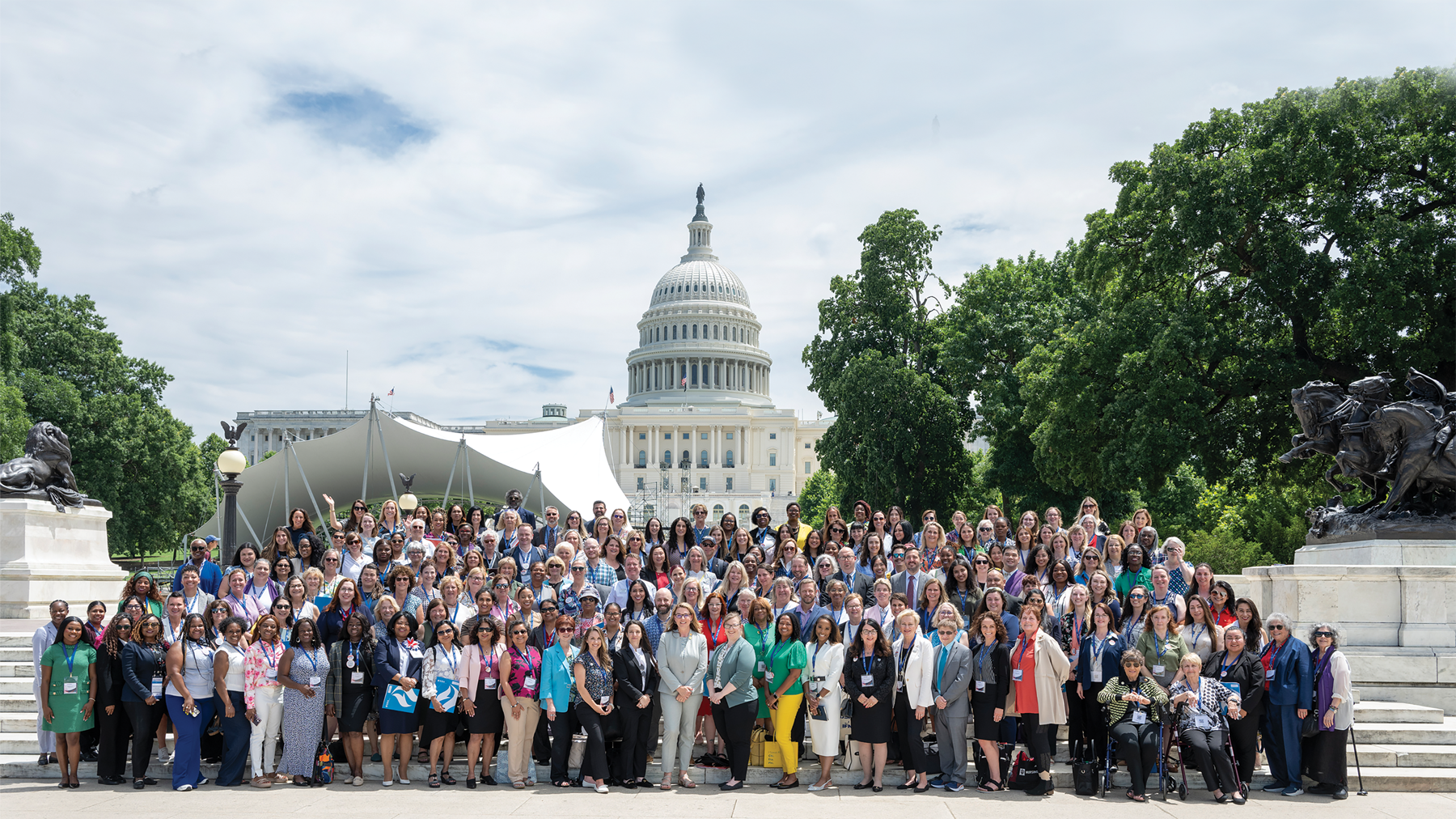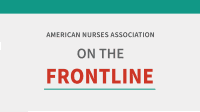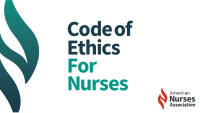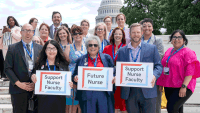Nurses meet evolving issues with compassion and resolve.
Ready to tackle some of the most compelling issues in the profession, nurse leaders from across the U.S. came together at the 2024 American Nurses Association (ANA) Membership Assembly, the governing and official voting body of ANA, June 28-29 in Washington, D.C. Nearly 400 attendees addressed mental healthcare stigma in their profession, improvements in care for military veterans, the upcoming revision to the Code of Ethics for Nurses with Interpretive Statements, and other timely and relevant nursing and healthcare issues.
The Assembly is composed of representatives from ANA’s constituent and state nurses associations (C/SNAs), the Individual Member Division, and specialty nursing organizational affiliates (OAs), as well as the ANA Board of Directors. Eligible voting representatives elected national leaders to serve on the board of directors and nominations and elections committee (See Elected leaders).
In her opening address, ANA President Jennifer Mensik Kennedy, PhD, MBA, RN, NEA-BC, FAAN, welcomed attendees, saying that they had gathered “to ensure that our policies, our programs, and our activism do justice to the knowledge and power of our members and the more than 5 million RNs that we represent.”
Nurses embrace challenges, set course for brighter future
Making history: When nursing succeeds, health care succeeds
Pressing priorities
Among top concerns, Mensik Kennedy emphasized that the persistent nurse staffing crisis has “far-reaching consequences for both nurses and patients … when nurses are overburdened, the quality of care and patient safety significantly decline.”
She commended the combined efforts of ANA and its C/SNAs to address the nurse staffing crisis. “Together, we can address this critical issue, ensuring safe staffing levels for nurses and equitable, high-quality care for all patients,” she said. “We will continue to engage with all organizations and agencies to further the co-branded ANA and American Association of Critical Care Nurses Nurse Staffing Task Force recommendations on these long-term challenges.”
Mensik Kennedy underscored the need to provide the elderly with the care they deserve and ANA’s ongoing and vigorous support to preserve the long-term care staffing rule, a key message nurses carried to Capitol Hill on ANA Hill Day, June 27.
To raise visibility of the nurse staffing crisis among policy makers and national media, ANA launched a provocative advertising campaign which served as a call to action for the need to support and empower nurses. These ads, placed in seven key locations across the D.C. metro area, ran throughout the month of June.
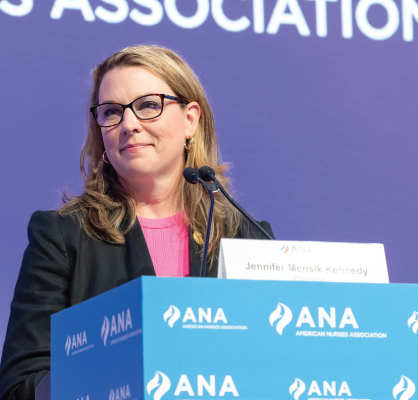

Highlighting another priority issue, Mensik Kennedy called out the “intolerable” level of workplace violence that nurses experience and the toll that gun violence takes on nurses and the communities they serve. She highlighted ANA’s efforts to combat workplace violence, such as urging the Occupational Safety and Health Administration (OSHA) to develop and enforce specific standards for employers to protect healthcare professionals and convening a national workplace violence prevention committee to develop a public health strategy and provide resources for nurses.
“We’re aggressively pushing both Congress and the Department of Labor for stronger standards and accountability for actions on workplace violence,” Mensik Kennedy said. “Simply put, Congress and OSHA need to do their jobs. But making workplace violence a felony is not sufficient. We need to prevent violence from happening.”
Addressing a vexing and persistent challenge in the nursing profession, Mensik Kennedy noted steps ANA has taken on its own and in collaboration with other nursing organizations to confront racism in nursing and advance diversity, equity, inclusion, belonging and accessibility. This work—including awarding a total of $200,000 to 10 organizations with evidence-based initiatives to dismantle systemic racism and contributing $100,000 in grants specifically to support C/SNA projects in this space—is ongoing.
“Through these actions, we strive to examine and overcome the systemic racism in the workplace that harms all of us, but especially nurses of color,” she noted. “I also want to thank the C/SNAs for your parallel efforts to combat racism in your communities.”
Looking ahead: Imagining ANA in 2040
ANA Enterprise Interim CEO Angela Beddoe, who was subsequently appointed CEO in August, began her remarks by expressing gratitude to all those who have provided support during her transition into the role.


Beddoe conveyed the need for ANA not only to advance its current operational and strategic priorities but also to consider “how our decisions affect us 10 minutes from now, 10 months from now, and 10 years from now … the ANA of the future requires us to innovate now to address the exponential changes unfolding across healthcare and our society,” she said.
With the future in mind, Beddoe introduced an enterprise-wide initiative designed to keep ANA at the forefront of the nursing profession by “incorporating excellence into everything we do.”
This initiative, Integrating Excellence: Imagining ANA in 2040, “will involve taking a good look at the environment we’re in today and what we anticipate the landscape will look like in 2040, and how we continue to serve the nursing profession with best-in-class practices, innovation, engagement, education, anticipating emerging markets, research, advocacy, nursing programs, and financial vitality,” she explained.
“We need to reach for the stars and see where we go and grow,” Beddoe said. “And most importantly, we need to do it together.”
Dynamic discussions


In the first of three dialogue forums, delegates considered how licensure and employment policies have created a stigma that interferes with nurses seeking support for their mental and emotional well-being. They also discussed recommended actions to dismantle these systemic barriers.
Representatives commented that the stigma that nurses face when they experience mental health or addiction issues may keep impaired nurses on the job. Several attendees shared that they had lost to suicide colleagues who were struggling with substance use disorder. Others pointed out the high cost of addiction treatment.
The Assembly voted to accelerate changes to mental health reporting requirements and normalize the process for nurses to seek help for workplace-related stresses.
The second dialogue forum focused on recommendations for action to ensure that all healthcare providers, including RNs, are adequately prepared to provide the highest level of care to military veterans receiving community care outside the Veterans Health Administration (VHA).
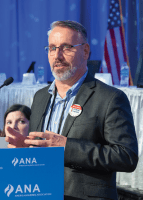

Several representatives explained that U.S. military veterans have unique mental health challenges, and some are dealing with the effects of exposure to dangerous chemicals. Few RNs are trained on how to best treat veterans. Some commenters relayed their own experience providing care to veterans who have struggled to get their needs met.
The Assembly voted to consider VA Community Care a supplement to care delivery by the VHA, and to work to improve nursing knowledge relating to the unique healthcare needs of the veteran population and their families.
The third dialogue forum concerned an upcoming revision of the Code of Ethics for Nurses with Interpretive Statements, with delegates providing feedback on the proposed changes for the 2025 version. Public comments on the revision closed in July.
In addition to its policy actions, the Membership Assembly also approved a scheduled dues escalation starting in 2025.
Aiming high
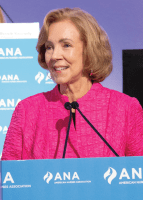

In her report to the Assembly, ANA Enterprise CNO Debbie Hatmaker, PhD, RN, FAAN, thanked members for coming together to demonstrate “the power of nurses.”
“It is this body—representing nearly every corner of the nation—that sets the priorities for nursing,” said Hatmaker. “You are activists, change-makers, experts, leaders, educators, and more.”
In support of ANA’s commitment to confront racism in nursing, Hatmaker reported on the formation of the Racial Reckoning Think Tank in partnership with ethnic minority nursing associations. “We are approaching this work intentionally, ensuring that the right voices and lived experiences are represented,” she said.
“We expect the outcomes from the Think Tank to offer meaningful recommendations to advance an anti-racist profession.”
Hatmaker provided a report to the Assembly on progress made on last year’s dialogue forum recommendations on the topics of virtual nursing, preventing gun violence, and documentation burden. In one action, ANA is developing a national policy that addresses standardization of virtual nursing and has convened a Professional Issues Panel to advise ANA. The focus will be on principles and guidelines to implement and incorporate virtual nursing into nursing practice.


ANA is also advocating for legislation to address gun safety and access, to increase funding for mental health services, and for research on gun violence against healthcare professionals. In November 2023, ANA established the National Workplace Violence Prevention Committee to advise the staff for further refinement of these related efforts. ANA’s position statement, Incivility, Bullying and Workplace Violence, has been revised. During the meeting, the organization released a statement applauding the Surgeon General’s declaration of gun violence as a public health crisis.
While the 2023 Assembly called for a national consensus for research and policy development to lessen the burden of nursing documentation, an extensive consultation found no existing avenue or partnership to move toward that goal. ANA will consider convening its own workgroup to move these recommendations forward, as determined by programmatic priorities.
Hatmaker commented on ANA’s forward-thinking response to the rapid evolution of healthcare technology.
“We are seeing daily the dramatic changes being wrought across all professions by the introduction of artificial intelligence (AI),” she said. “I am proud of the work ANA did to release an official position statement on AI that can inform and guide nurses.”
Other actions and activities
Assembly representatives heard new business, approving motions regarding the ethics and transparency of ANA’s financial investments and developing a policy to evaluate all external partners for alignment with the organization’s ethical standards. The Assembly did not approve a motion recommending that the ANA Board of Directors endorse a candidate in the 2024 U.S. presidential election.
Nurses had the opportunity to participate in lunchtime discussions on timely issues, including reimbursement models, nurse-led efforts to strengthen the healthcare safety net, and what nurses need to know about AI. Representatives from ANA’s 37 specialty nursing OAs met to share information about their initiatives and discuss ways to partner on nursing issues.
The American Nurses Foundation raised more than $15,000 in donations, and the ANA-PAC brought in close to $30,000 during the Assembly.
Recognizing exceptional nurses
ANA celebrated the 2024 President’s and National Awards recipients at a ceremony preceding Membership Assembly on June 27. Past ANA President Beverly Malone, PhD, RN, FAAN, was inducted into the ANA Hall of Fame. Past American Nurses Credentialing Center President Rhonda Anderson, DNSc(h), MPA, BS, RN, LFACHE, FAAN, and Past ANA President Pamela Cipriano, PhD, RN, NEA-BC, FAAN, were honored with President’s Awards, with a third award presented to the leaders of the Congressional Nursing Caucus during the Hill Day breakfast briefing. ANA also honored 14 exceptional nurses in eight additional categories. See the complete list of National Award winners: myamericannurse.com/ana-enterprise-news-may-2024/.
View leaders’ presentations from Membership Assembly and the National Awards on ANA’s YouTube channel at youtube.com/user/nursesmatter.
—Elizabeth Moore is a content creator and Genna Rollins is a writer/editor at ANA.
American Nurse Journal. 2024; 19(9). Doi: 10.51256/ANJ092474

